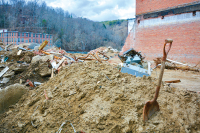Lake Emory headed toward oblivion one grain at a time
There’s a story, perhaps apocryphal, about how a bunch of drunks overturned their boat one night in Lake Emory just outside of Franklin.
Macon County’s emergency services and law enforcement turned out en masse. They arrived to discover the drunks bobbing about holding onto the sides of their boat, desperately awaiting rescue. The cops studied the situation for a moment; then cupped their hands around their mouths and hollered out: “Put down your feet.” The drunks did as bidden, and walked unaided to the shore across silt-filled Lake Emory.
That’s an amusing tale — unless your home happens to be situated next to the 174-acre lake, as is the case for Shirley Ches and her husband, Jim.
The couple moved to their lakefront home in Franklin about 20 years ago. They were excited about living in the mountains and alongside water in an area they both loved. While they remain enamored with the beauty of these mountains and the region they call home, these days the couple has soured on the whole lakefront experience.
Shirley Ches, in particular, is frustrated by the silt and downed trees in Lake Emory. She is irritated by years of promises made by county and town leaders that something will be done, only for nothing to ever actually happen. Ches is tired of studies in Macon County that don’t lead to action; of talk that hasn’t led to results.
The silt buildup, Ches said during a guided walking tour along the lake of the couple’s slice of paradise, is the end result of storm damage that started with the blizzard of 1993 and continued with numerous tropical storms in the years that followed.
Related Items
Before and after pictures tell the story visually. Back at the house, Ches has spread out photo albums on the dining room table for her version of show-and-tell. There are photos of Jim fishing, and of her grandchildren playing in the lake, pictorial reminders of all-around-fun-times in the mountains that people who retire to Western North Carolina dream about when they are living in hot and sandy Florida.
Then came those storms. Silt from development upstream, from the former town dump on Radio Hill nearby, from virtually everywhere that can be conceived, poured down into Lake Emory, Ches said.
SEE ALSO: To Duke’s chagrin, dredging may be in the cards for Emory
The lake is positioned a short distance below the convergence into the Little Tennessee River of the Cullasaja River, Cartoogechaye Creek and smaller tributaries.
Trees, too, were knocked down in these storms. The trees washed into the lake, helping to fill it with more debris and provide still more crevices for silt to build up against.
Ches’ photographs of her grandchildren playing in Lake Emory transition to ones featuring her son. He’s wading in mud, acres and acres of mud, with a chainsaw in hand, cutting trees downed by the storms. Sisyphus-like, really, in his efforts to help his parents reclaim their dream — one man cannot cleanup a lake, however, no matter how determined he might be.
The lake, it seems, is headed for a future as a shallow wetland at best, mudflat at worst, if years of accumulated sediment aren’t dredged by Duke Energy, which owns the lake and dam as part of its hydropower network.
A developer’s dream
Lake Emory doesn’t just represent an implosion of the dream Shirley and Jim Ches once had of the merry life they’d lead once residing on its shores. Lake Emory is one of the first of the many boom-and-bust housing developments that today litter WNC and scar the region’s mountains — dollar signs turned to dust, a ghost lake of sorts.
That said, Lake Emory does have its own beauty, sort of. There is something primordial about this shallow lake — the silt has formed into islands here and there. It’s sort of like watching the earth form. There are large expanses of wetlands, too. Birds, insects and wildlife use the lake, and locals do catch fish here, though it’s not exactly a Fontana Lake-experience. There are not going to be any national bass-fishing competitions anytime soon on Lake Emory, as any large bassboats launched in Lake Emory might run aground.
Like Fontana, and most of the lakes that dot WNC, Lake Emory is manmade.
In the 1920s, a group of residents formed the Lake Emory Company and started pushing for a lake in Macon County near Franklin. They wanted it for fishing, swimming and boating. They also wanted a power dam to generate electricity for the local community, plus a golf course and a 75-room motel to attract tourists, according to a history of the project compiled by Jamie Johnston, the former executive director of the Little Tennessee Watershed Association, a locally based conservation group.
The lake, the group decided, would be stocked with a variety of game fish for sportsmen, and hunters could come and shoot the many ducks that surely would use the lake for nesting and resting on their migration routes to other place.
The lake was expected to attract thousands of visitors. Estimates of projected income varied from $750,000 to $1 million annually, according to news accounts at the time.
Lured by these promises, the Town of Franklin in 1925 created Lake Emory by funding a $300,000 bond to pay for a 35.5-foot tall, 463-feet long dam on the Little Tennessee River.
The town owned the dam; Lake Emory Company was left to market and develop the surrounding property. That part of the project never really got off the ground, however. There would be no motel, and no golf course — just a small hydroelectric dam that sucked up Franklin taxpayer dollars at an alarming rate.
The town eventually offloaded the dam to Northwest Carolina Utilities, only to see ownership return when the company failed to make a bond payment in the early 1930s.
In 1932, the town transferred title to Nantahala Power and Light Company, which later morphed into Duke Energy. Today, the two hydro generators at Porter Bend Dam on Lake Emory produce just more than one megawatt. This, according to Duke District Manager Fred Alexander, represents a mere 1 percent of the generating capacity of Duke hydroelectric projects in its Nantahala Area of southwestern North Carolina.
Reasons not to dredge
A hop, skip and a jump away in Haywood County, a similar situation developed over the years at Lake Junaluska: silt filled the manmade lake there, too. But unlike at Lake Emory, the question in Haywood County wasn’t whether to dredge, just about how to actually pay for dredging. Once that was solved, dredging promptly took place, and the lake was again a showpiece for those living along its shores. Dredging is now done on a routine schedule every few years.
That, however, isn’t the case in Macon County. Lake Emory, unlike Lake Junaluska, isn’t home to a group of well-heeled Methodists with united will and enough money to get the job done. Lake Emory is a place where everyday people such as Shirley and Jim Ches live in small, modest homes; outsiders, for the most part, without much political clout.
Last month, if there wasn’t already enough to hinder anything being done (and at least two of the town’s aldermen were then pushing for dredging), one of the region’s most respected environmentalists weighed in with his reasons not to dredge Lake Emory.
Macon County resident Bill McLarney, who oversees biomonitoring work for the Little Tennessee Watershed Association, strongly cautioned against digging into the muck that makes up Lake Emory. McLarney, during a noontime luncheon and unveiling of the group’s State of the Streams report at a League of Women Voters’ meeting, said he worried dredging Lake Emory would risk stirring up monsters of the deep — toxic pollutants that could be buried deep in the silt.
There were great amounts of questionable materials being discharged into Lake Emory in the 1960s from plants in neighboring Rabun County, Ga., McLarney said, in those years before federal regulations came into play to prevent toxic spewing.
Churn that stuff up, and you risk the overall health of the 13-mile stretch of the Little Tennessee River below Porter Bend Dam, he said.
“I really hadn’t thought about that before,” Franklin Alderman Bob Scott, formerly a proponent of dredging Lake Emory who was pushing Duke to get off its duff and do just that, said after hearing McLarney.
Scott left convinced a lot more study needs to take place before any silt gets disturbed, if it ever does.
Ches, too, was at that meeting. An avid Democrat, a frequent letter writer to local newspapers on a variety of left-leaning issues, she is frustrated by the reactions of what would normally constitute her natural allies — a liberal such as Scott, an environmentalist such as McLarney. Even the local sportsmen haven’t readily embraced her dream of a lake where they could more easily hunt and fish and play.
Who really can say that dredging wouldn’t actually help the Little Tennessee River? Ches argued. And, she added, while she cares, too, about those little creatures in the river just like McLarney does, she and her neighbors are the ones who have to actually live next to the lake.









